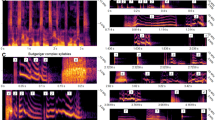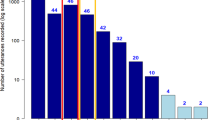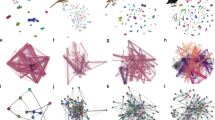Abstract
Humans regularly produce new utterances that are understood by other members of the same language community1. Linguistic theories account for this ability through the use of syntactic rules (or generative grammars) that describe the acceptable structure of utterances2. The recursive, hierarchical embedding of language units (for example, words or phrases within shorter sentences) that is part of the ability to construct new utterances minimally requires a ‘context-free’ grammar2,3 that is more complex than the ‘finite-state’ grammars thought sufficient to specify the structure of all non-human communication signals. Recent hypotheses make the central claim that the capacity for syntactic recursion forms the computational core of a uniquely human language faculty4,5. Here we show that European starlings (Sturnus vulgaris) accurately recognize acoustic patterns defined by a recursive, self-embedding, context-free grammar. They are also able to classify new patterns defined by the grammar and reliably exclude agrammatical patterns. Thus, the capacity to classify sequences from recursive, centre-embedded grammars is not uniquely human. This finding opens a new range of complex syntactic processing mechanisms to physiological investigation.
This is a preview of subscription content, access via your institution
Access options
Subscribe to this journal
Receive 51 print issues and online access
$199.00 per year
only $3.90 per issue
Buy this article
- Purchase on Springer Link
- Instant access to full article PDF
Prices may be subject to local taxes which are calculated during checkout




Similar content being viewed by others
References
Hockett, C. F. The origin of speech. Sci. Am. 203, 89–96 (1960)
Chomsky, N. Syntactic Structures (Mouton, The Hague, 1957)
Hopcroft, J. & Ullman, J. Introduction to Automata Theory, Languages, and Computation (Addison-Wesley, Reading, Massachusetts, 1979)
Hauser, M. D., Chomsky, N. & Fitch, W. T. The faculty of language: what is it, who has it, and how did it evolve? Science 298, 1569–1579 (2002)
Fitch, W. T., Hauser, M. D. & Chomsky, N. The evolution of the language faculty: clarifications and implications. Cognition 97, 179–210 (2005)
Eens, M. Understanding the complex song of the European starling: An integrated approach. Adv. Study Behav. 26, 355–434 (1997)
Gentner, T. Q. & Hulse, S. H. Perceptual mechanisms for individual vocal recognition in European starlings, Sturnus vulgaris. Anim. Behav. 56, 579–594 (1998)
Gentner, T. Q. & Hulse, S. H. Perceptual classification based on the component structure of song in European starlings. J. Acoust. Soc. Am. 107, 3369–3381 (2000)
Gentner, T. Q. & Margoliash, D. Neuronal populations and single cells representing learned auditory objects. Nature 424, 669–674 (2003)
Hauser, M. D., Newport, E. L. & Aslin, R. N. Segmentation of the speech stream in a non-human primate: statistical learning in cotton-top tamarins. Cognition 78, B53–B64 (2001)
Hauser, M. D., Weiss, D. & Marcus, G. Rule learning by cotton-top tamarins. Cognition 86, B15–B22 (2002)
Fitch, W. T. & Hauser, M. D. Computational constraints on syntactic processing in a nonhuman primate. Science 303, 377–380 (2004)
Pinker, S. & Jackendoff, R. The faculty of language: what's special about it? Cognition 95, 201–236 (2005)
Acknowledgements
We thank T. Brawn for help in conducting some of these experiments, and A. Henly, P. Visser and L. Kay for comments on an earlier draft. This research was supported by an NIH grant to D.M.
Author information
Authors and Affiliations
Corresponding author
Ethics declarations
Competing interests
Reprints and permissions information is available at npg.nature.com/reprintsandpermissions. The authors declare no competing financial interests.
Supplementary information
Supplementary Note
This file contains the Supplementary Methods, Supplementary Discussion, Supplementary Tables and Supplementary Figures. (PDF 1351 kb)
Rights and permissions
About this article
Cite this article
Gentner, T., Fenn, K., Margoliash, D. et al. Recursive syntactic pattern learning by songbirds. Nature 440, 1204–1207 (2006). https://doi.org/10.1038/nature04675
Received:
Accepted:
Issue Date:
DOI: https://doi.org/10.1038/nature04675
This article is cited by
-
Uniquely human intelligence arose from expanded information capacity
Nature Reviews Psychology (2024)
-
Super Linguistics: an introduction
Linguistics and Philosophy (2023)
-
Bare and Constructional Compositionality
International Journal of Primatology (2023)
-
Learning and organization of within-session sequences by pigeons (Columba livia)
Animal Cognition (2023)
-
Lessons learned in animal acoustic cognition through comparisons with humans
Animal Cognition (2023)
Comments
By submitting a comment you agree to abide by our Terms and Community Guidelines. If you find something abusive or that does not comply with our terms or guidelines please flag it as inappropriate.



